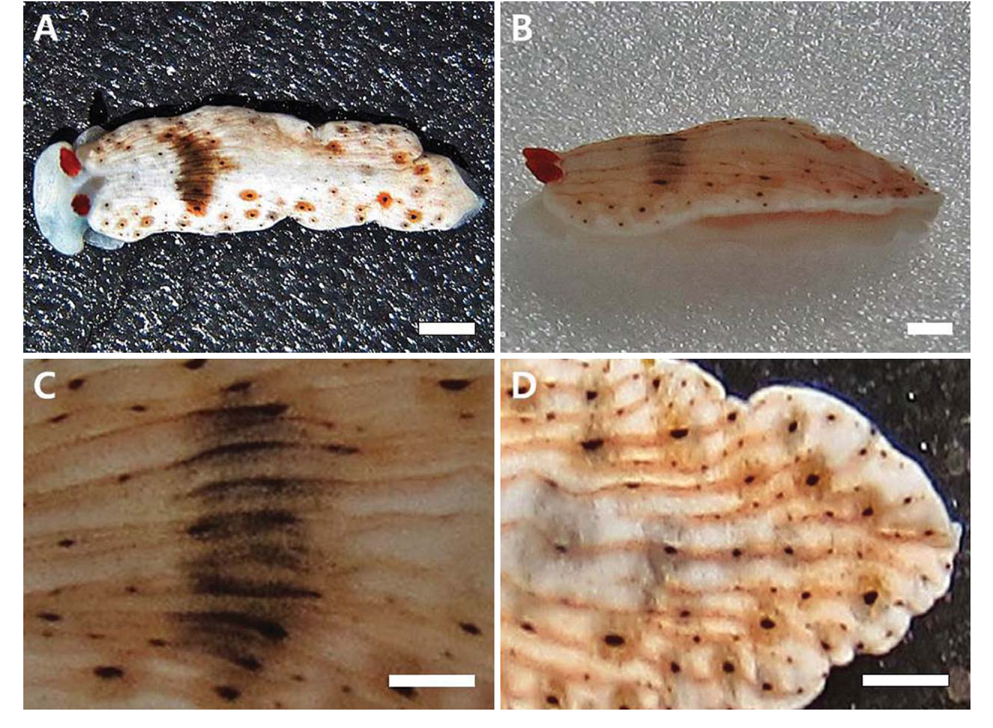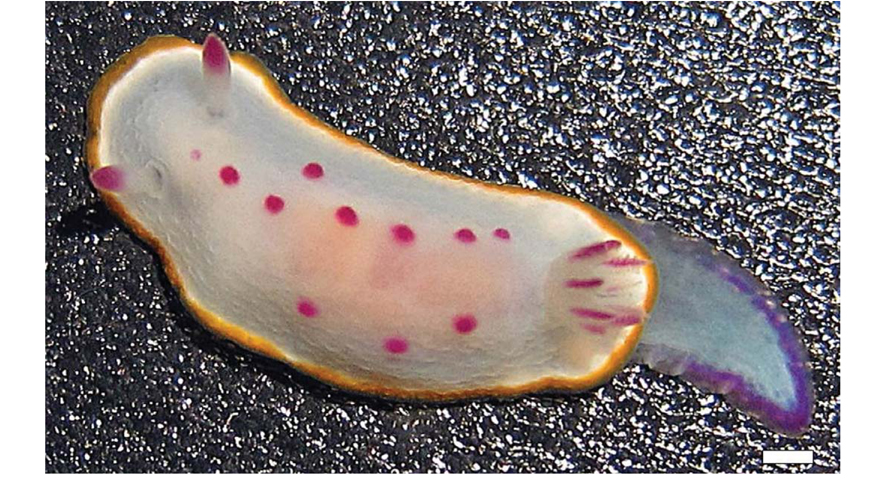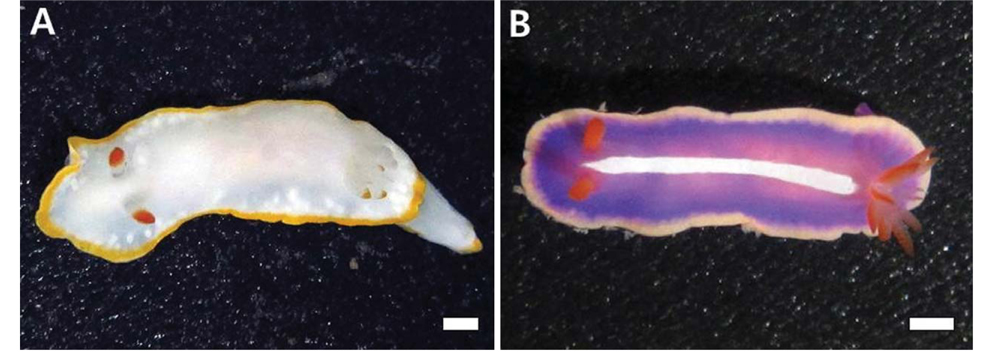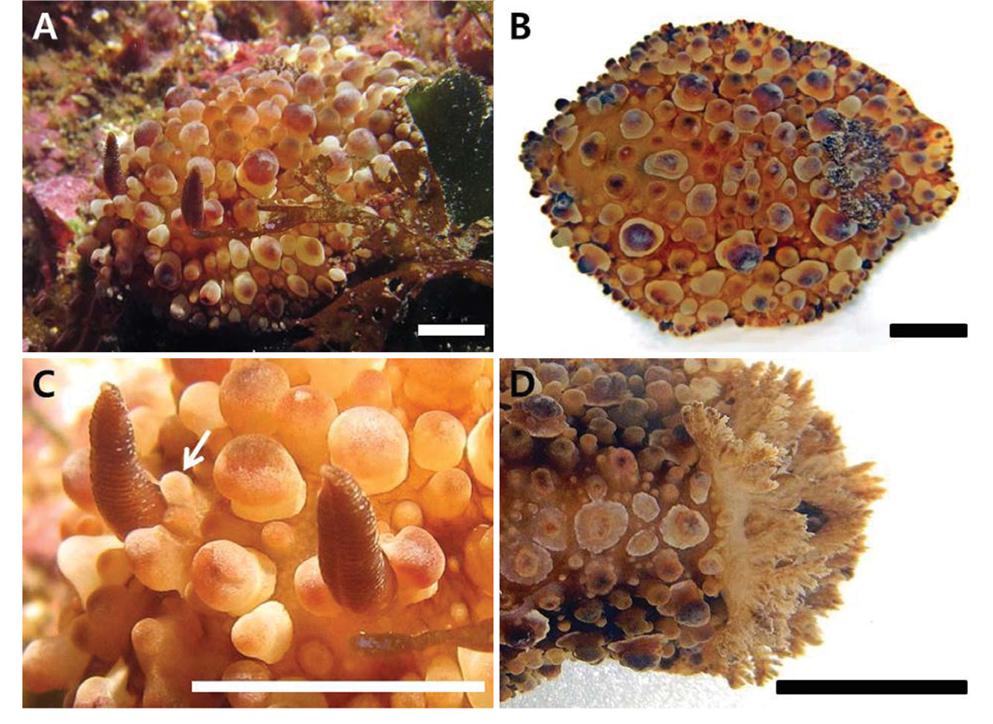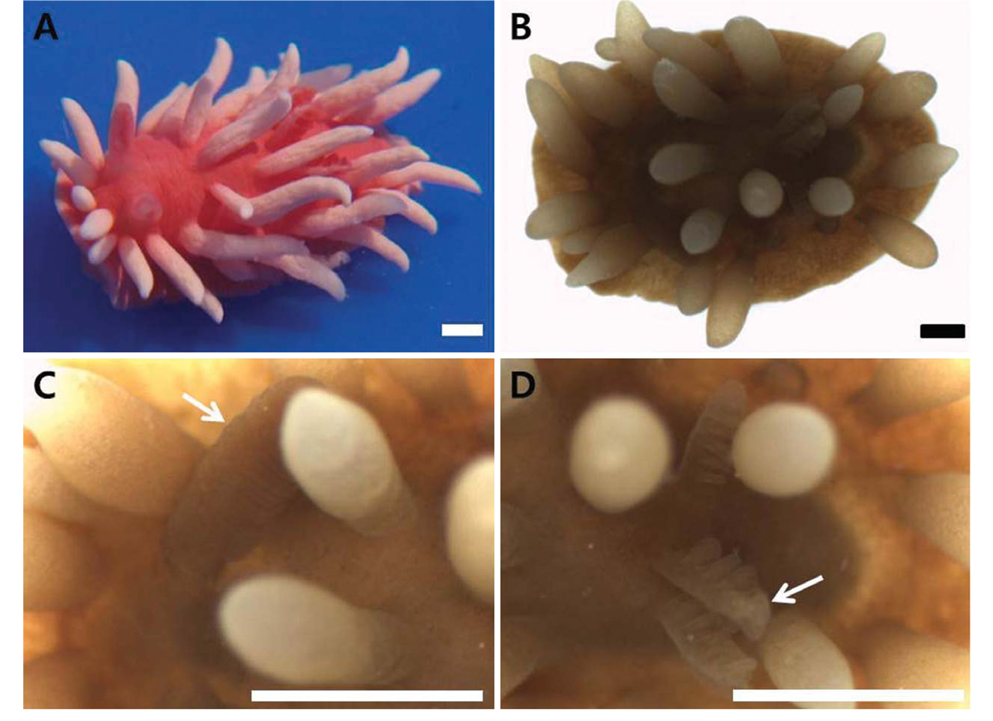



Species in the order Nudibranchia are characterized by a lack of shell in adult stage, highly diverse body form and various mechanical and chemical defense mechanisms(Yonow, 2008). Nudibranchs include more than 6,000 species worldwide (Gosliner et al., 2008). Despite the high global diversity of nudibranchs, only 38 species have been reported in Korea (Choe, 1992; Choe and Lee, 1994, 1997; Lee and Min, 2002; Choi, 2003; Jung et al., 2013a, 2013b). Herein, we briefly describe five species as being new to Korean fauna:
Specimens were collected by scuba diving in the sub-tidal zone of the Korean coast from January 2011 to August 2013. They were preserved in 10% neutral buffered formalin or 97% ethanol. A stereoscopic microscope(Olympus SZ-61 with FuzhouTucsen TCA-3; Olympus, Tokyo, Japan) was used to examine the specimens. Body length was measured from the anterior end to the tip of the metapodium. The specimens examined were deposited at the National Institute of Biological Resources(NIBR), Incheon, Korea and Sangmyung University, Seoul, Korea. The specimen numbers for NIBR were indicated in the information for the corresponding specimens.
Genomic DNA was extracted from the foot of the animal by using the DNA AccuPrep Genomic DNA Extraction Kit (Bioneer, Daejeon, Korea). PCR amplification was executed for mitochondrial COI sequences using a metazoan universal primer set(LCO1490, HCO2198)(Folmer et al., 1994). PCR products were purified and sequenced using a 3730xl DNA Analyzer(Applied Biosystems, Foster City, CA, USA). Each primer was removed and, by translating the sequences, the numts were checked using Geneious pro 5.0.4(Drummond et al., 2010). Mitochondrial COI sequences from the species examined were deposited in the GenBank (accession numbers: KF648916-20).
Phylum Mollusca Linnaeus, 1758 Class Gastropoda Cuvier, 1795 Order Nudibranchia Cuvier, 1817 Family Arminidae Iredale and O’Donoghue, 1923 Genus Dermatobranchus van Hasselt, 1824
Pleuroleura striata: Eliot, 1913: 41, 42(not Dermatobranchus striatus van Hasselt, 1824). Dermatobranchus striatus: Baba, 1937: 316, 317, Pl. 2, fig. 1, text-fig. 12; 1949: 73, 157, 158, Pl. 29, fig. 109, text-fig. 83; 1976: 4-6, figs. 1-2 (not Dermatobranchus striatus van Hasselt, 1824). Dermatobranchus otome Baba, 1992: 242-245, figs. 3-5, Pl. 1, fig. 3; Okutani, 2000: 801; Gosliner and Fahey, 2011: 273-275, figs. 20-21.
Material examined. Korea: 1 individual, Jeollanam-do: Sinan-gun, Heuksan-myeon, Gageo-do, 13 Oct 2011; 5 individuals, Jeju-do: Jeju-si, Udo, 29 Jun 2013; 1 individual, Jeju-do, Jeju-si, Dodu-dong, 30 Jun 2013; 21 individuals, Jeju-si, Hangyeong-myeon, Gosan-ri, 12 Jul 2013(KOSPIV000018 6276).
Description. Body elongate(length, 9-23 mm; width, 3-7 mm) and milky white to pale pink (Fig. 1A, B). Oral veil smooth and large, milky white; extend with rounded margin. Rhinophores locate behind the oral veil; red rhinophoral clubs with longitudinal lamellae, each tip of rhinophoral clubs bright red or white; stalk colorless and slightly narrower than club. Head veil indistinct. Whole dorsum covered with numerous longitudinal ridges, ridges extend in parallel; ridges white to pale pink; depression of between ridges lighter color than ridges. A transversal band of semilunar shape locate about two-fifths of body length from anterior end of dorsum, mostly dark brown to black(Fig. 1C); rarely weak gray. Numerous black spots surrounded by grayish pink ocellus on dorsal surface (Fig. 1D). Ventral mantle and foot white. Lateral side of body smooth without lamellae. Genital orifices and anus locate on right side of body under the mantle; genital orifices situate about one-seventh of body length from anterior end. Anus locates two-fifth of body length from anterior end and beside the dorsal transversal band.
Distribution. Korea, Japan.
Remarks. Forty-one valid species have been recorded in the genus Dermatobranchus(Bouchet, 2013).
Family Chromodorididae Bergh, 1891 Genus Mexichromis Bertsch, 1977
Goniodoris festiva Angas, 1864: 53-54, Pl. 4, fig. 12. Hypselodoris festiva: Basedow and Hedley, 1905: 142[not (Hypselodoris festiva Adams, 1861)](cited from Rudman, 1983). Chromodoris festiva: Bergh, 1893: 417-419, Pl. 4, figs. 18-22; Burn, 1965: 88; Rudman, 1973: 194, 196, table 1. Mexichromis festiva: Rudman, 1983: 155-158, figs. 12G, 21, 23; Baba, 1989: 15-19, figs. 3-5; Debelius and Kuiter, 2007: 209.
Material examined. Korea: 1 individual, Gyeongsangbuk-do, Ulleung-gun, Seo-myeon, Namyang-ri, 2 Aug 2013(KO SPIV0000186277).
Description. Body elongately ovate(length, 19mm; width, 9 mm), ground color translucent white. Rhinophoral clubs lamellate and reddish purple in color, stalks translucent white and slightly narrower than clubs. Gills 9 and unipinate, encircled anus, translucent white with reddish purple edge. Mantle margin golden yellow, sometimes broken. Submarginal band white. Small conical tubercles cover entire dorsum, translucent white or colorless. Several reddish purple mammillary tubercles round and low profile scattered dorsum. Metapodium end blunted. Weak purple striped submarginal band extends from both sides of head to tip of metapodium; posterior of the band darker than anterior. Sole opaque white. Oral tentacles digitiform, short, tips reddish purple. Genital orifices locate right side of body and about one-fifth of body length from anterior end.
Distribution. Korea, Japan, Hong Kong, Eastern Austrailia.
Remarks.
Genus
[Table 1.] Comparison of diagnostic characters distinguishing Noumea nivalis and N. purpurea

Comparison of diagnostic characters distinguishing Noumea nivalis and N. purpurea
Noumea nivalis Baba, 1937: 298, 299, text-fig. 4; 1949: 54, 144, text-fig. 61, Pl. 19, fig. 68; 1987: 23; Rudman, 1985: 250-254, figs. 1, 6, 7A; Rudman and Darvell, 1990: 55, Pl. 5D; Okutani, 2000: 791; Debelius and Kuiter, 2007: 205; Gosliner et al.,2008: 249. Noumea decussata: Abe, 1964: 49, 50, fig. 18, Pl. 22, fig. 80 (not Noumea decussata Risbec, 1928). Chromodoris alba: Orr, 1981:31(not Doris alba van Hasselt, 1824)(cited from Rudman and Darvell, 1990).
Material examined. Korea: 9 individuals, Jeju-do: Jeju-si, Hangyeong-myeon, Gosan-ri, 12 Jul 2013; 1 individual, Gyeongsangbuk-do: Ulleung-gun, Seo-myeon, Namyang-ri, 2 Aug 2013(KOSPIV0000186278).
Description. Body elongately ovate(length, 8-13mm; width, 5-8mm). Ground color milky white. Rhinophores lamellate, clubs reddish orange, stalks colorless. Gills 7-9 and unipinate, form a circle surrounding anus, translucent white, sometimes one or more tips with an orange spot. Mantle narrow, thin, slightly undulated. Mantle with a yellow marginal band. Numerous white mantle glands locate inside the marginal band. Few orange spots on dorsal surface in few specimens. Metapodium with blunted end, translucent white, sometimes with yellow tip. Ventral side of mantle, oral tentacles, and sole translucent white. Oral tentacles digitiform. Genital orifices locate right side of body and one-fourth of body length from anterior end.
Distribution. Korea, Japan, Hong Kong.
Remarks. This species is similar to
Noumea purpurea Baba, 1949: 55, 144, 145, Pl. 19, fig. 70, text-fig. 63; Rudman, 1986: 311-316, figs. 1-3; Okutani, 2000: 791; Lee and Min, 2002: 145; Choi, 2003: 35, 36; Debelius and Kuiter, 2007: 203; Gosliner et al., 2008: 245. Noumea gloriosa: Abe, 1964: 50, Pl. 23, fig. 81(not Chromodoris gloriosa Bergh, 1874). Noumea norba Marcus and Marcus, 1970: 161-163, figs. 19-22; Rudman, 1984, fig. 17D, E. Thorunna gloriosa: Bertsch and Johnson, 1981: 60(t: 143op photo only; not Chromodoris gloriosa Bergh, 1874).
Material examined. Korea: 1 individual, Jeju-do: Seogwipo-si, Seogwi-dong, 27 Jun 2013; 1 individual, Jeju-si, Dodu-dong, 1 Jul 2013.
Description. Body elongate, ovate(length, 7-10mm; width, 4-5mm). Body light pinkish purple. Rhinophores lamellate, clubs and stalks vermilion. Gills 10 and unipinate, form a circle surrounding anus, same color as rhinophores. Mantle narrow and thin. Mantle marginal band weak yellow to apricot. Mantle submarginal band deep purple. A thick white line on middle of dorsum extends from rhinophores to gills. Metapodium light pinkish purple with pointed end. Ventral side of mantle, oral tentacles, and sole deep pinkish purple. Oral tentacles digitiform. Genital orifices locate right side of body and one-fifth of body length from anterior end.
Distribution. Korea, Japan, Hawaii, Marshall Islands, Fiji, Australia.
Remarks.
Family Discodorididae Bergh, 1891 Genus Hoplodoris Bergh, 1880
Carminodoris armata Baba, 1993: 223-226, figs. 1-6. Hoplodoris armata: Domínguez et al., 2006: 153, table 1.
Material examined. Korea: 1 individual, Jeju-do: Seogwipo-si, Seongsan-eup, Seongsan-ri, 15 Jan 2011; 2 individuals, Gyeongsangnam-do: Tongyeong-si, Yokji-myeon, 7 May 2011; 1 individual, Gyeongsangbuk-do: Ulleung-gun, Ulleung-eup, Dokdo-ri, 4 Aug 2013; 1 individual, Ulleung-gun, Ulleung-eup, Dokdo-ri, 5 Aug 2013(KOSPIV0000186279).
Description. Body ovate and swollen (length, 42-51 mm; width, 29-33mm). Ground color yellowish brown (Fig. 4A). Rhinophoral clubs lamellate and dark brown; stalk opaque brown. Each rhinophoral sheath with a couple of large tubercles; sometimes supplemented with a small tubercle(Fig. 4C). Gills six and trippinate, form a circle surrounding anus. Marginal gill pocket tuberculate(Fig. 4D). Mantle wide and covers whole foot. Mammillary tubercles cover dorsum, single rounded and vary in size; several mammillary tubercles encircled by white to bright yellow ring (Fig. 4B); some tip of mammillary tubercles chocolate brown or dark gray. Ventral side of mantle, oral tentacles and sole opaque brown. Oral tentacles digitiform. Anterior foot bilabiate. Genital orifices locate right side of body and one-fourth of body length from anterior end.
Distribution. Korea, Japan.
Remarks. Baba(1993) suggested that
Family Goniodorididae H. Adams and A. Adams, 1854 Genus Okenia Menke, 1830
Hokinsiella hiroi Baba, 1938: 10-11, fig. 7; 1949: 47, 48, 139, 140, Pl. 16, fig. 56, Text-fig. 49. Hokinsia hiroi: Bouchet and Ortea, 1983: 231, 232; Rudman and Darvell, 1990: 38, Pl. 1G; Okutani, 2000: 779. Okenia hiroi: Rudman, 2004: 42-45, figs. 20B, 21, 24D, 27B, 30B; Debelius and Kuiter, 2007: 21.
Material examined. Korea: 1 specimen, Gyeongsangnam-do: Goseong-gun, Jugwang-myeon, Munamjin-ri, 1 Mar 2013; 3 specimens, Jeju-do: Seogwipo-si, Seongsan-eup, Seongsan-ri, 28 Mar 2013(KOSPIV0000180746).
Description. Body ovate and flat(length, 5-10mm; width, 3-8mm). Ground color pale pink to deep red. Head, mantle and foot combined (Fig. 5A, B). Rhinophores short, rounded end, with 12-16 lamellae; lamellae absent in frontal part (Fig. 5C). Gills 3-5, short, arched in front of anus (Fig. 5D). Dorsal papillae 23-34, digitiform, asymmetry, pale pink to deep red, white tips. Oral tentacles absent. Ventral groove presents between head and foot. Genital orifices locate right side of body and one-third of body length from anterior end.
Distribution. Korea, Hong Kong, Japan.
Remarks.

